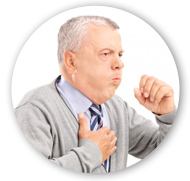Dry Cough/Non-Productive Cough:

There is no phlegm or no sputum production. The throat and upper airways become inflamed. It is of three types:
- Dry hacking cough - A short, weak repeating cough, often caused by irritation of the larynx by a postnasal drip.
- Barking cough - Also called Croup. It is a viral infection that results in swollen vocal cords and throat.
- Whooping Cough - Another name for pertussis, an airways infection caused by the bacteria called Bordetella pertussis. The patient coughs continuously, after which there is a characteristic whoop sound and a strong intake of breath.
Wet Cough/Productive Cough:
A productive cough produces phlegm or mucus (sputum). The mucus may have drained down the back of the throat from the nose or sinuses or come up from the lungs. A productive cough generally should not be suppressed-it clears mucus from the lungs.

Conditions associated with this type of cough include:
- Common cold: A wet cough with a runny nose, sneezing, watery eyes, low-grade fever (below 101.5°F), and postnasal drip (mucus running down the back of the throat). Symptoms can last 2 to 14 days, but most people recover within 10 days.
Expectorants like guaifenesin can help you "cough up" or expel mucus. Antitussives, such as dextromethorphan, can be used to treat the cough.
- Chronic Obstructive Pulmonary Disease (COPD)/Chronic Bronchitis: A wet cough with mucus, shortness of breath, tightness of the chest, and wheezing. It is caused by Cigarette smoking or other long-term exposure to air pollutants or lung irritants. COPD is a life-long condition and requires medical care.
 There is no phlegm or no sputum production. The throat and upper airways become inflamed. It is of three types:
There is no phlegm or no sputum production. The throat and upper airways become inflamed. It is of three types:



 Conditions associated with this type of cough include:
Conditions associated with this type of cough include: